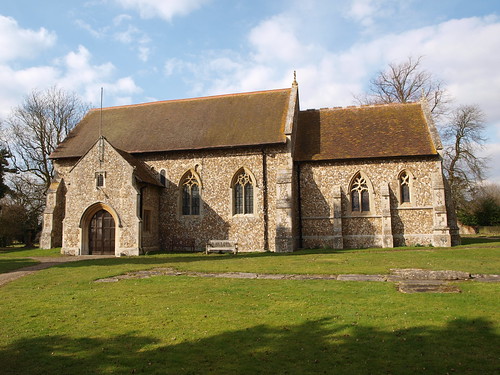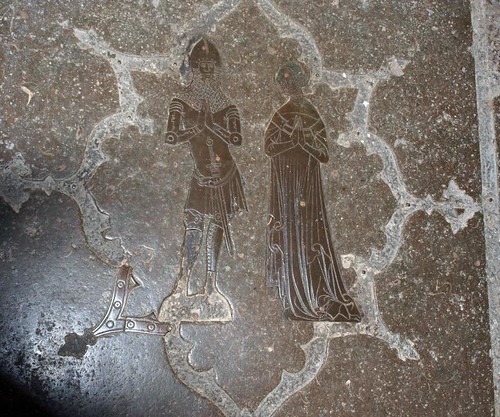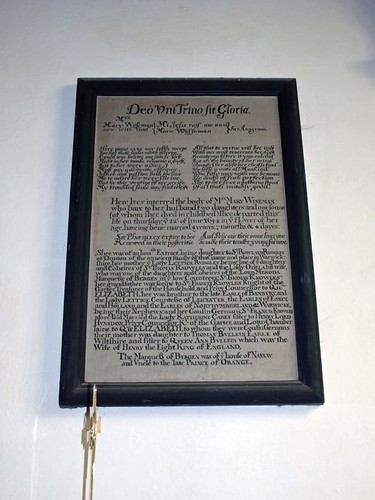All Saints is lovely but understandably locked as it is fairly isolated, however a sign states that it is open at weekends but each time I've gone back it has been locked. Perseverance might one day pay off, we'll wait and see.
UPDATE: Having visited Radwinter last Saturday I came back via Wimbish in the forlorn hope that it might be open and to my astonishment finally gained access. A very nice lady was flower arranging and let me photograph the interior.
It's a nice church with good screens, a very early brass - I think the earliest I've seen but I'd need to check that - and a strange stair doorway close to the south door - if it's a rood screen door it's in a funny place - in what appears to be a Norman window.
If for no other reason I liked the interior since it led me to putting Mary Wiseman in my family tree.
ALL SAINTS. Norman nave (see one S window and the S doorway, with two orders of columns, one of them spiral-carved and with volute capitals, the other smooth and with one-scallop capitals; both have plaited rings below the capitals). The C13 made alterations to this Norman nave, but it is not easy to understand them. The only evidence is a blank pointed arcade outside, just above the Norman window. What was its purpose? Inside, the N arcade is also C13. It has quatrefoil piers and double hollow-chamfered arches. N aisle and S porch C15. Chancel 1868, W tower taken down in 1883 and not yet rebuilt. The N aisle roof is dated 1534 in one of the graceful tracery spandrels of the braces. - SCREEN to the N chapel; one-light divisions with ogee heads and mouchettes above; C15.- MONUMENT. Sir John de Wantone d. 1347 and wife. An unusual and delightful piece. Two small brasses, only 18 in. long, both in the elegant, swaying attitudes of that age. The figures are set in the head of an octofoil cross. The style is very similar to that of the most accomplished of English brasses, that of Sir Hugh. Hastings at Elsing in Norfolk (d. 1347).
UPDATE: Having visited Radwinter last Saturday I came back via Wimbish in the forlorn hope that it might be open and to my astonishment finally gained access. A very nice lady was flower arranging and let me photograph the interior.
It's a nice church with good screens, a very early brass - I think the earliest I've seen but I'd need to check that - and a strange stair doorway close to the south door - if it's a rood screen door it's in a funny place - in what appears to be a Norman window.
If for no other reason I liked the interior since it led me to putting Mary Wiseman in my family tree.
ALL SAINTS. Norman nave (see one S window and the S doorway, with two orders of columns, one of them spiral-carved and with volute capitals, the other smooth and with one-scallop capitals; both have plaited rings below the capitals). The C13 made alterations to this Norman nave, but it is not easy to understand them. The only evidence is a blank pointed arcade outside, just above the Norman window. What was its purpose? Inside, the N arcade is also C13. It has quatrefoil piers and double hollow-chamfered arches. N aisle and S porch C15. Chancel 1868, W tower taken down in 1883 and not yet rebuilt. The N aisle roof is dated 1534 in one of the graceful tracery spandrels of the braces. - SCREEN to the N chapel; one-light divisions with ogee heads and mouchettes above; C15.- MONUMENT. Sir John de Wantone d. 1347 and wife. An unusual and delightful piece. Two small brasses, only 18 in. long, both in the elegant, swaying attitudes of that age. The figures are set in the head of an octofoil cross. The style is very similar to that of the most accomplished of English brasses, that of Sir Hugh. Hastings at Elsing in Norfolk (d. 1347).
The church is in a lovely setting of trees, and has nave walls and a little window of the 12th century. Of about the same age is the handsome doorway, protected by a 15th century porch whose upper room is reached by a stairway in the thickness of the wall. The double door has been opening and shutting since Henry the Seventh was on the throne. Handsome columns have been standing in the nave for 700 years; a board painted with texts and commandments was here before the Spanish Armada sailed; and the Tudor roof of the aisle has a fine rose in one spandrel, balanced by the arabic figures 1534. Two 14th century screens are very finely traceried, and from the same age are some glass flowers and shields and yellow leopards. Here are two of the oldest brass portraits in Essex. They show Sir John de Wautone of 1347 and his Ellen, he looking much as a warrior at Crecy must have looked, his lady very gracefully dressed. The portraits are set in the head of a cross, the only impress of a brass cross in the county; and below is the impress of an elephant, the badge of the Beaumont family.
Simon K -
All Saints, Wimbish, Essex
Pleasantly set in a a farmyard away from the road, looking its major
restoration from without, but it sounds interesting within. It is
actually at the edge of the village of Radwinter.
I was taken by a sudden whim to head on to Sturmer and Birdbrook, both of which would surely have been locked for the night, and get the train from Bury or Sudbury. But fortunately sweet reason prevailed and I turned west again to Saffron Walden and Audley End station.
Locked, but a notice said welcome to our church, you may step in and enjoy the peace or somesuch, so I guess they had already locked it.
I was taken by a sudden whim to head on to Sturmer and Birdbrook, both of which would surely have been locked for the night, and get the train from Bury or Sudbury. But fortunately sweet reason prevailed and I turned west again to Saffron Walden and Audley End station.
I got the 1745, arriving Cambridge at 1808 and had another 40 minutes
heel-kicking before the train home to Ipswich. I'd visited 17
churches, 13 in Essex and 4 in Hertfordshire, most of them open,
though not all. It is the most churches I have visited in a single day
for nearly a year. Total distance cycled about 60 miles.



No comments:
Post a Comment